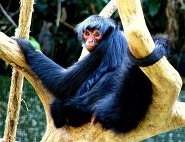 The black spider monkey (Ateles paniscus), is found in the Amazon Rainforests on the topmost branches of trees. It has a long tail which acts as a fifth limb making it the most agile and acrobatic monkey of its family.
The black spider monkey (Ateles paniscus), is found in the Amazon Rainforests on the topmost branches of trees. It has a long tail which acts as a fifth limb making it the most agile and acrobatic monkey of its family.The head and body length of the black spider monkey is about 14-26 inches (35-66 cm) and it has a longer tail as compared to its body - 25-36 inches (60-80 cm). The weight of the monkey at birth is about 0.45 kg (1 lbs) and a mature monkey is approximately 7.8 kg (17.35 lbs).
The black spider monkey reaches its sexual age when it is five years of age and the female becomes mature at the age of four. There is no particular breeding season for this species and the female gives birth to its younger ones after 232-235 days of conception. They give birth to only one baby at a time and that too, after an interval of two to three years. These monkeys like to roam about in groups and are very active during the day time. They thrive on fruits, nuts, and leaves for their survival. Their lifespan is quite long as compared to other species. They can live up to 20 years and in captivity, they may survive for more than thirty years.
The monkey leads a nomadic life and roams about in groups. The number of monkeys in a group varies and it depends on the accessibility of food. For every square km of a forest, there are generally eighteen black spider monkeys but the number can reach up to 100 if the food is available in good quantities.
Every morning, the monkey group disperses in two or four smaller groups in search of food. Since it is quite large in size, there is no threat to its life from eagles or other such dangerous species and so, it does not require the protection of any large group. While feeding, the female monkeys keep in touch with other monkeys by loud calls. Along with fruit and nuts, these monkeys also feed on insects, bird's eggs, spiders, flower buds, and seeds.
However, an unfortunate part of the story is that the spider monkey is gradually becoming extinct because of constant hunting. Since it is a noisy and large animal, it becomes an easy target for arrows and darts. Moreover, its reproduction rate is very low and it matures slowly because of which, in some of the regions, it has been completely wiped out. The destruction of rainforests is also one of the reasons for its extinction.
Picture of the black spider monkey by Ana_Cotta, licensed under theCreative Commons Attribution 2.0 License .
Which zoos have them?
Artis (Netherlands)The Black spider monkey, red-faced black spider monkey is listed as Least Concern. Does not qualify for a more at risk category. Widespread and abundant taxa are included in this category, on the IUCN Red List of Threatened Species
Namings for the black spider monkey
A young / baby of a black spider monkey is called a 'infant'. A black spider monkey group is called a 'troop, barrel, tribe or cartload'.Some facts about the
Black spider monkey
Adult weight : 7.888 kg (17.3536 lbs)
Maximum longevity : 46 years
Female maturity :1516 days
Male maturity : 1280 days
Gestation : 229 days
Weaning : 795 days
Litter size : 1
Litters per year : 1
Interval between litters : 1072 days
Weight at birth : 0.453 kg (0.9966 lbs)
Weight at weaning : 3.79 kg (8.338 lbs)

Custom Search